
In the ever-evolving landscape of project management and software development, “What is Agile Methodology?” stands as a fundamental question for those seeking efficient and adaptive approaches. Whether you’re new to the concept or seeking a refresher, this overview will shed light on the essentials of Agile Methodology and its transformative impact on modern workflows.
In this article, we’ll show you why Agile management is so popular in project development.
Here are some of the things you’ll learn from this article:
✅ How Agile management compares to other popular management methods
✅ Variations of Agile management
✅ Agile management principles and when to use it
According to the State of Agile Report in 2023, Agile is more relevant than ever. The principles and practices of Agile methodology continue to be top of mind for many enterprises. Key takeaways from the report are:
- “4 out of 5 respondents say their organization has Agile teams distributed geographically”
- “While over 7 in 10 respondents say they are satisfied with the Agile practices in their company, half are somewhat satisfied and 1 in 5 very satisfied”
- “Among those who are satisfied with Agile practices at their company, 7 in 10 say they are satisfied because of increase collaboration and over half because of a better alignment to business needs“
- “Almost 9 in 10 respondents say they are currently leveraging Scrum while over half are currently leveraging Kanban“
- “Company culture and a lack of management support are the leading causes of unsuccessful delivery with Agile”
- “Among those not satisfied with Agile practices at their company, the top reason is because their company still has many legacy systems requiring a mixed approach“

Agile Methodology Definition
Agile methodology is a pivotal project management approach predominantly applied in software development. It embodies a dynamic process where demands and solutions evolve through the synergistic collaboration of self-organizing, cross-functional teams, and their engaged customers.
The Agile methodology is rooted in a set of principles (see next chapter) valuing adaptability and flexibility. Agile stands as a transformative force, enhancing responsiveness to ever-changing business needs.
It empowers teams to deliver tangible progress in incremental, workable increments, fostering a climate of continuous improvement.
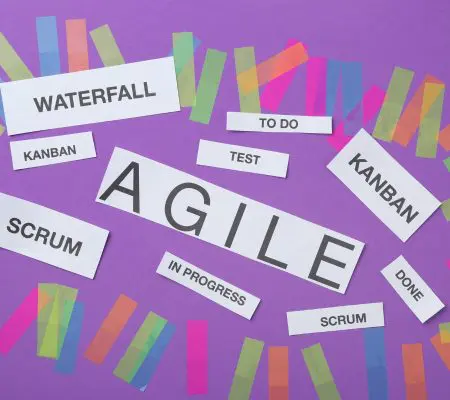
What Is the Agile Manifesto?
The Agile Manifesto is a declaration of the values and principles expressed in Agile methodology. Made up of four foundational values and 12 key principles, it aims to help uncover better ways of developing software by providing a clear and measurable structure that promotes iterative development, team collaboration, and change recognition.
The values and principles of the ‘Manifesto for Agile Software Development’ are:
Agile Manifesto Values:
-
- Individuals and interactions over processes and tools
- Working software over comprehensive documentation
- Customer collaboration over contract negotiation
- Responding to change over following a plan
Agile Manifesto Principles:
-
- Customer satisfaction through early and continuous software delivery
- Accommodate changing requirements throughout the development process
- Frequent delivery of working software
- Collaboration between the business stakeholders and developers throughout the project
- Support, trust, and motivate the people involved
- Enable face-to-face interactions
- Working software is the primary measure of progress
- Agile processes to support a consistent development pace
- Attention to technical detail and design enhances agility
- Simplicity
- Self-organizing teams encourage great architectures, requirements, and designs
- Regular reflections on how to become more effective
Derived from the foundational values and principles outlined in the Agile Manifesto, Agile methodology emerged as a direct response to the limitations inherent in traditional development approaches, notably the rigid constraints of the Waterfall method. In the dynamic landscape of the software industry, characterized by intense competition and the ever-present need for continuous updates, Agile methodology proves indispensable.
Unlike the linear and sequential nature of the Waterfall method, Agile embraces iterative processes and adaptive planning, allowing development teams to respond swiftly to evolving requirements and deliver enhanced products in a timely manner.
Agile vs Waterfall Methodology: A Quick Comparison
| Criteria | Agile | Waterfall |
|---|---|---|
| Adaptability | Extremely adaptable, allowing quick responses to changes and evolving technology. | More rigid structure, best suited for projects with a clear and unchanging vision. |
| Project Timeline | Flexible timeline dependent on project development. | Fixed timeline planned from the start. |
| Project Phases | Concurrent work on phases with tight deadlines, team-driven direction. | Linear progression through defined stages, driven by project manager. |
| Flexibility in Direction | Allows for changes even late in the process, suitable for evolving projects. | Less flexibility due to a predefined and unchanging vision. |
| Budget Flexibility | Budget subject to change as project direction evolves. | Less flexible budget planned from the start. |
| Ideal for | Software development where technology evolves rapidly. | Projects with a clear and specific vision that won’t change. |
| Stakeholder Feedback | Continuous stakeholder feedback is incorporated throughout. | Deliverables for each stage are clearly defined before moving on. |
In summary, Agile is best suited for dynamic, evolving projects, while Waterfall is ideal for projects with a well-defined and unchanging vision. The choice between the two methodologies depends on factors like adaptability, project timeline, and the need for stakeholder feedback.
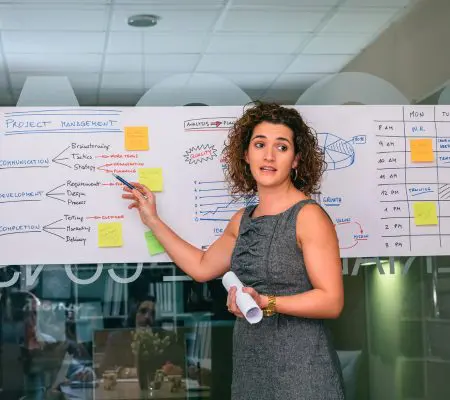
What Is Agile Project Management?
Agile project management stands as a versatile methodology widely employed for steering complex projects, owing to its inherent adaptiveness. At its core, this approach prioritizes collaboration, flexibility, continuous improvement, and the pursuit of high-quality results. In the quest for clarity and measurability, Agile harnesses six primary deliverables, acting as crucial benchmarks to monitor progress and shape the final product.
Agile Methodology Steps
These are the deliverables found in Agile project management:
-
- Product vision statement: A concise summary that vividly articulates the overarching goals and purpose of the product. This serves as the North Star, providing a guiding vision for the entire project team.
- Product roadmap: Offering a high-level overview, the product roadmap delineates the key requirements essential for realizing the product vision. It acts as a strategic blueprint, aligning the team’s efforts with the broader objectives.
- Product backlog: A comprehensive, prioritized list outlining all the necessary elements for the project’s success. The product backlog serves as a dynamic repository that evolves over time, capturing the evolving needs and priorities of the project.
- Release plan: A structured timetable detailing the planned releases of the working product. This component provides a strategic timeline, ensuring that deliverables align with project goals and external milestones.
- Sprint backlog: Focused on the current sprint, the sprint backlog encompasses user stories, goals, and tasks. It serves as a detailed action plan, guiding the team through the specific objectives of the ongoing iteration.
- Increment: The tangible outcome of each sprint, the increment represents the functional aspects of the product presented to stakeholders. This not only facilitates continuous feedback but also allows for potential customer delivery, enhancing transparency and collaboration.
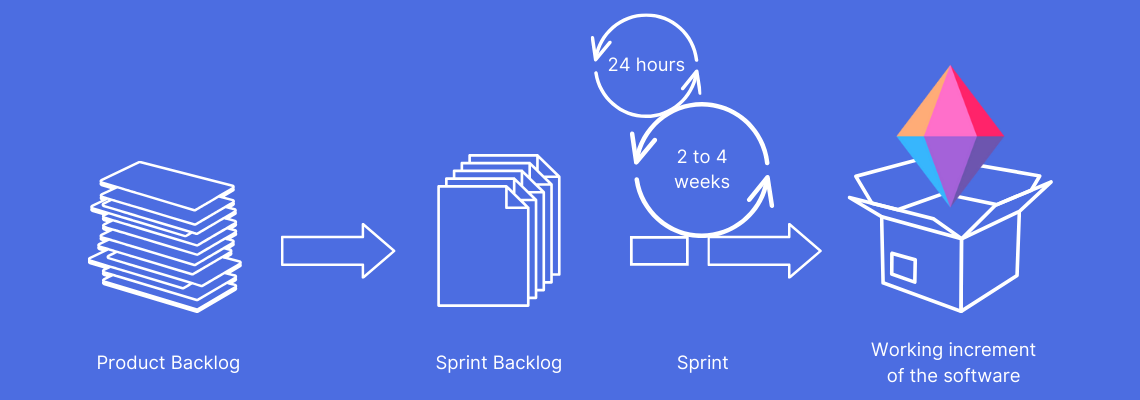
There are various frameworks within Agile project management that can be used to develop and deliver a product or service. Each framework highlights a specific approach and focuses on a determined outcome. Depending on the requested outcome, the particular approach of Agile is chosen and applied. While they each have their own set of characteristics and terminology, they share common principles and practices.
Two of the most popular ones that support the Agile development life cycle are Scrum and Kanban.
Agile Scrum Methodology
Scrum is an Agile framework that is used to implement the ideas behind Agile software development. It is the most popular Agile framework used in companies. Created by Jeff Sutherland and Ken Schwaber (who were also part of the 13 individuals who cemented the Agile Manifesto), it comprises five values: commitment, courage, focus, openness, and respect. Its goal is to develop, deliver, and sustain complex products through collaboration, accountability, and iterative progress.
What distinguishes Scrum from other Agile methodologies are the roles, events, and artifacts that it is made up of, and with which it operates. Here’s what they are:
Scrum Team Roles
- Product owner: The product expert and voice of stakeholders in Agile Scrum, the Product Owner defines the product vision, prioritizes features, and ensures development aligns with business goals. This role demands a deep understanding of market demands and a strategic vision.
- Development team: Comprising skilled professionals like developers, programmers, and designers, the Development Team drives product delivery. Emphasizing self-organization, collective ownership, and continuous improvement, they collaborate closely to transform requirements into tangible outcomes.
- Scrum master: The organized servant-leader integral to applying Scrum principles seamlessly. Beyond facilitating events and removing impediments, the Scrum Master nurtures a culture of continuous improvement, guides the team in embracing Agile values, and champions efficiency, fostering an environment for the Scrum framework to thrive.
Scrum Events
- Sprint: In Scrum, it’s a brief period for the development team to complete specific tasks, milestones, or deliverables—essentially dividing the project schedule into manageable time blocks not exceeding one month.
- Sprint planning: At the start of every Sprint, the entire Scrum team gathers to plan the upcoming sprint.
- Daily Scrum: A 15-minute daily meeting during the Sprint to discuss the previous day’s achievements and expectations for the next one.
- Sprint review: An informal end-of-sprint meeting where the Scrum team presents their Increment to stakeholders and discusses feedback.
- Sprint retrospective: A meeting where the Scrum team reflects on the previous Sprint and establishes improvements for the next one.
Scrum Artifacts
- Product backlog: Managed by the Product Owner, it lists all requirements for a viable product in order of priority. Includes features, functions, requirements, enhancements, and fixes authorizing changes in future releases.
- Sprint backlog: A list of tasks and requirements for the next Sprint, sometimes visualized using a Scrum task board in a ‘To Do, Doing, and Done’ format.
Kanban
Kanban is a highly visual method popularly used within Agile project management. It paints a picture of the workflow process, with an aim to identify any bottlenecks early on in the process so that a higher quality product or service is delivered.
Kanban Agile methodology has six general practices:
-
- Visualization
- Limiting work in progress
- Flow management
- Making policies explicit
- Using feedback loops
- Collaborative or experimental evolution
A concept that was developed in the production line of Toyota factories in the 1940s, Kanban achieves efficiency through visual cues to signal certain stages of the development process. The said cues are a Kanban board, Kanban cards, and sometimes even Kanban swimlanes.
- Kanban board: A visual management tool used to visualize the development process. It can be either physical (a whiteboard, sticky notes, and markers) or virtual (like an online project management tool), and can be used for personal productivity, as well as professional use.
- Kanban cards: Cards that depict a work item/task in the work process. Used to communicate progress with your team, it represents information such as status, cycle time, and impending deadlines.
- Kanban swimlanes: A visual element on the board that allows you to further distinguish tasks/items by categorizing them. Flowing horizontally, it offers distinction and provides a better overview of the workflow.
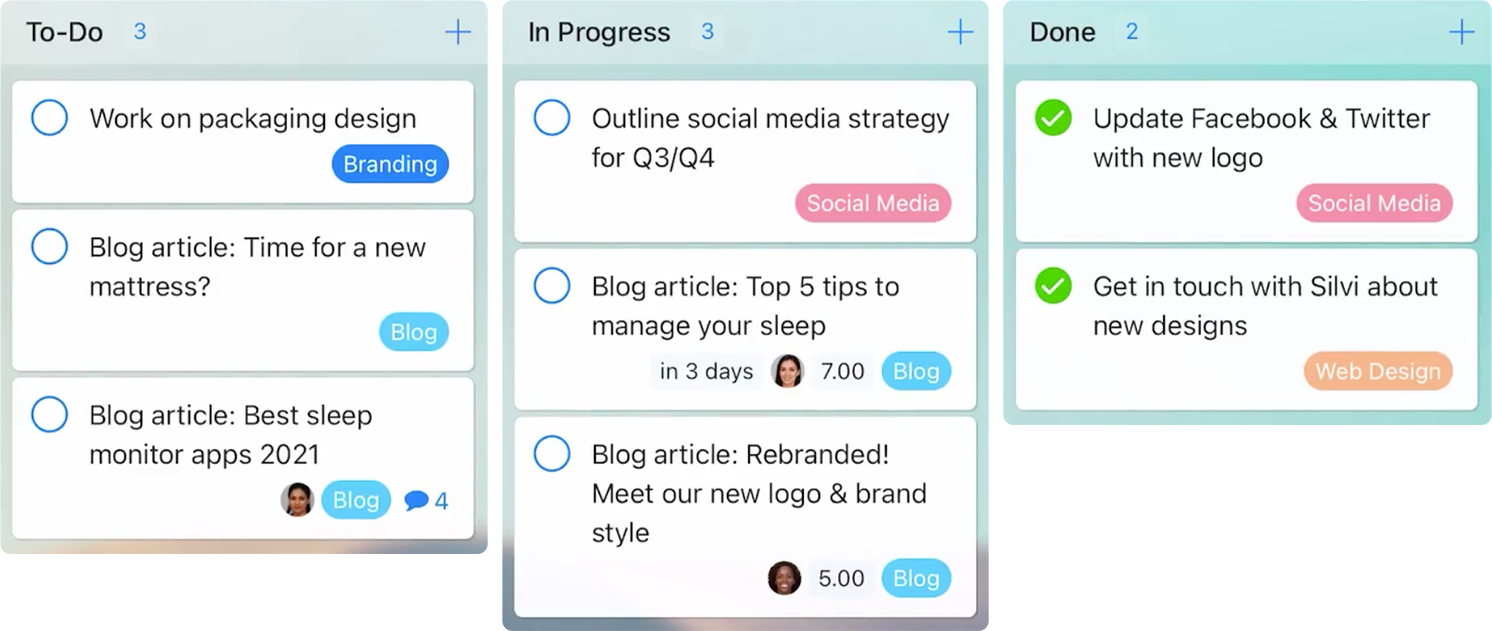
Approach your tasks your way.
Task prioritization made simple with Zenkit Projects’ Kanban Board.
Get started for free now.
Scrum and Kanban lead as popular Agile methodologies, prized for their adaptability and effectiveness. Scrum’s structured sprints and defined roles promote collaboration, while Kanban’s visual approach excels in identifying bottlenecks and supporting continuous improvement. Their popularity stems from their ability to meet the diverse needs of modern project management within the Agile framework.
One methodology which builds on these foundations for a more comprehensive approach to streamline workflos and enhance project management efficency is Lean Agile.
What Is Lean Agile Methodology?
The Lean Agile Methodology is a development method that assists teams in identifying waste and refining processes. It’s a way of thinking that promotes efficiency, effectiveness, and continuous improvement.

Lean Agile, also known as lean software development, is based on lean manufacturing principles. Instead of relying solely on increased sales, the concept was introduced into manufacturing to improve profits by lowering costs. A company can save money by eliminating waste and becoming more efficient, which increases overall profits.
Lean Agile Principles
Lean Agile methodology has 5 core principles:
- Identify Value: Lean Agile focuses on recognizing and delivering value, aligning efforts with project goals for meaningful contributions.
- Map the Value Stream: This principle visualizes the workflow to identify inefficiencies, eliminate non-value-added activities, and streamline processes for enhanced productivity.
- Create Flow: Lean Agile emphasizes a seamless flow of work by removing obstacles and bottlenecks, minimizing delays, and optimizing overall efficiency.
- Establish a Pull System: Implementing a pull system aligns work initiation with demand, reducing overproduction and enhancing adaptability to changing priorities.
- Seek Perfection: Lean Agile involves continuous improvement, encouraging a culture of learning and adaptation for optimal efficiency and high-quality work.
The Benefits of Lean Agile
- Less time is wasted
- Reduced costs
- Improved quality of work
Other Agile Development Life Cycle Approaches
Below you can find other important types of Agile methodology that can easily be overlooked. Other Agile methodology examples include:
Extreme Programming (XP)
XP is based on the five values of communication, simplicity, feedback, courage, and respect. XP is a framework that aims to produce a higher quality of life for the development team, as well as a higher quality product, through a collection of engineering practices. These practices are:
- The Planning Game
- Small Releases
- Metaphor
- Simple Design
- Testing
- Refactoring
- Pair Programming
- Collective Ownership
- Continuous Integration
- 40-hour Week
- On-site Customer
- Coding Standard
Crystal
Crystal comprises a family of Agile methodologies that include Crystal Clear, Crystal Yellow, and Crystal Orange. Their unique characteristics are guided by factors such as team size, system criticality, and project priorities. Key components include teamwork, communication, and simplicity, as well as reflection to regularly adjust and improve the development process. This Agile framework points out how each project may require a tailored set of policies, practices, and processes to meet the project’s specific characteristics.

Dynamic Systems Development Method (DSDM)
DSDM is an Agile methodology example that focuses on the full project lifecycle. It was created in 1994 after users of Rapid Application Development (RAD) wanted more governance and discipline in this iterative way of working. Based on eight principles, its philosophy is ‘that any project must be aligned to clearly defined strategic goals and focus upon early delivery of real benefits to the business.’
It promotes the use of the following practices so that it can offer best practice guidance for on-time, on-budget delivery of projects:
- Facilitated Workshops
- Modeling and Iterative Development
- MoSCoW Prioritisation
- Timeboxing
DSDM is designed to be independent of and can be implemented in conjunction with, other iterative methodologies.
Feature-Driven Development (FDD)
FDD is a lightweight iterative and incremental software development process. With an objective to deliver tangible, working software in a timely manner, it is an Agile methodology that entails specific, very short phases of work, which are to be accomplished separately per feature.
Its development process is established on a set of best practices with a client-value aim. The eight best practices are:
-
- Domain Object Modeling
- Developing by Feature
- Component/Class Ownership
- Feature Teams
- Inspections
- Configuration Management
- Regular Builds
- Visibility of Progress and Results
Agile Methodology Best Practices
It’s always handy to know how to do things best. Here are seven things you and your team should be doing when implementing any type of Agile methodology:
Customer Collaboration
Customer collaboration is a vital part of Agile methodology one of the core values stated in the Agile Manifesto. Through consistent communication with the development team, the customer should always be aware of the progress, and the combined effort will result in a higher-quality product.
User Stories
A tool used to explain a software feature from an end-user perspective, the purpose of a User Story is to create a simplified description of a requirement. It helps to picture the type of user of the product, what they want, and the reason(s) for it. A common User Story format that is used is:
As a [role], I want [feature], because [reason].
Continuous Integration
Continuous Integration (CI) involves keeping the code up to date by producing a clean build of the system a few times per day. With a rule stating that programmers never leave anything unintegrated at the end of the day, it enables the delivery of a product version suitable for release at any moment. What CI seeks to do is to minimize the time and effort required by each integration.
Automated Tests
Performing automated tests keeps the team informed about which of the code changes are acceptable, and whether or not a function is working as planned. Regression tests are run automatically before work starts.
Pair Programming
Programming in pairs aims to enhance better designs, fewer bugs, and a sharing of knowledge across the development team. One of the least-embraced Agile programmer practices, involves one programmer ‘driving’ (operating the keyboard), while the other ‘navigates’ (watches, learns, provides feedback). The roles can be rotated.
Test-Driven Development (TDD)
TDD aims to foster simple designs and inspire confidence. Instead of a process where software is added, that is not proven to meet requirements, it is a method based on the repetition of a very short development cycle where requirements are turned into test cases, and then the software is improved to pass the new tests.
Burndown Charts
A burndown chart is a graphical representation of the work that is left to do versus the time you have to do it. Using one as part of your Agile project management plan enables you to forecast when all the work will be completed. A detailed burndown chart will also include the number of User Stories per unit of time.
Final Thoughts
Agile methodology is an effective process for teams looking for a flexible approach to product development. No longer exclusive to the software industry, it can be implemented in any business venture that requires a non-linear plan of attack that also needs to value customer collaboration, effective teamwork, responsive changes, and of course, quality results.
How has Agile methodology improved your team’s way of working? Don’t forget to share your tips with us!
FREE 20 MIN. CONSULTATION WITH A PROJECT MANAGEMENT EXPERT
Wanna see how to simplify your workflow with Zenkit in less than a day?
Book a Live Demo


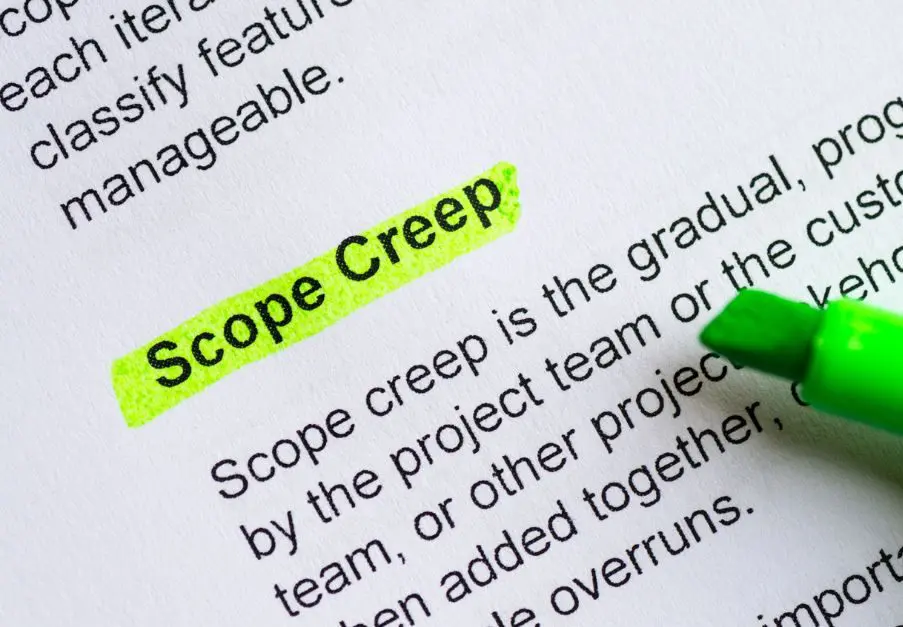

Leave a Reply